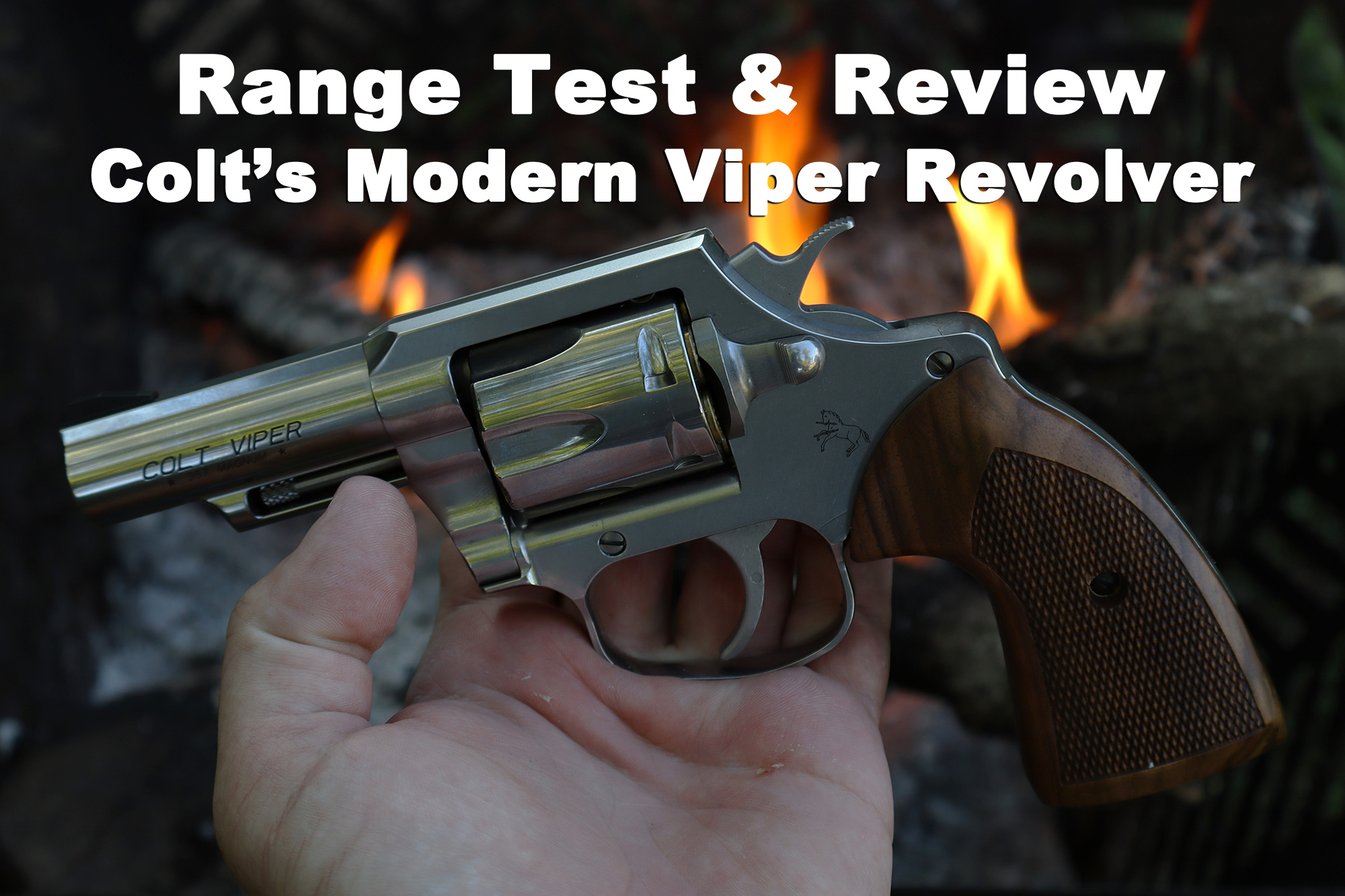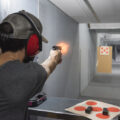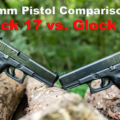A firing line review of Colt’s modernized Viper revolver. We take the new Colt Viper Revolver to the range for accuracy testing and more.
In 1977, Colt introduced the little-known snake gun in the Viper. The Viper was an upsized 4 inch barreled version of the popular aluminum-framed Cobra, a 2 inch snubnose chambered in .38 Special. It proved to be a one-year wonder as it was quickly discontinued with only a few thousand units sold. Once Colt began reentering the revolver market in 2017, the initial names that dropped were no surprise; The Cobra, the Python, the Anaconda.
The release of the new Colt Viper in 2024 took me by surprise. I mean, it is a model that barely existed in the first place. Indeed, the new Viper is a whole different animal. After several hundred rounds downrange, I came to the conclusion that it was a downsizing effort done right. Colt produced a fighting revolver that was just small enough for everyday carry while being heavy enough to control.
Colt Viper: The King Cobra on A Diet
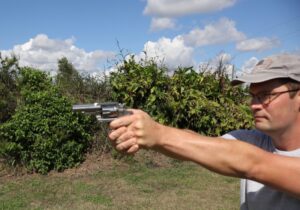
Viper vs Colt Cobra
The original Viper was an aluminum framed gun based on the small frame Cobra. Colt hoped that a longer grip and four inch barrel would make it easier to shoot while maintaining the weight savings of a non-steel frame. The new Viper has a passing resemblance to the old, but for all intents and purposes, it is based on the post-2019 King Cobra chambered in .357 Magnum. It has a passing similarity to the old Viper with a half underlug barrel. Otherwise, it is a King Cobra that exchanges the ugly stock rubber grips for a tasteful snag-free set of checkered Coke bottle style walnut stocks and fixed sights—a pinned front ramp and a rear square notch milled in the top strap of the frame.
What’s a Better Carry Option?
The sight arrangement and half-underlug barrel on the Viper are meant to make it more carry friendly compared to the King Cobra. But the Viper is neither a lightweight nor a heavyweight. The new Viper is all-stainless steel in construction. It features a one-piece barrel that features a recessed crown and an integral ejector rod shroud. My particular Viper comes with a 3 inch barrel, but a 4 ¼ inch barreled version is also available. Both have something to offer as each is long enough to take advantage of the .357 Magnum’s power while mitigating some of the blast.
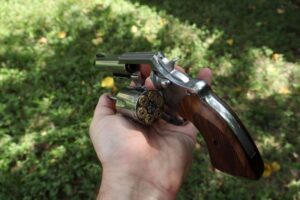
The new Viper features the characteristic clamshell Colt cylinder release on the left side of the cylinder frame. It is checkered vertically and lightly. Pulling back on the release allows you to swing the cylinder out for loading. It is a six-shot revolver and, unlike the original, is chambered for .357 Magnum ammunition. It will also shoot shorter .38 Special cartridges as well.
The Viper is a double action/single action revolver with an exposed hammer spur. You can fire the revolver by cocking the hammer for a lighter trigger pull in single action. Otherwise, you fire the gun by simply pulling the trigger, which cocks the hammer and releases it for you. That is double action mode.
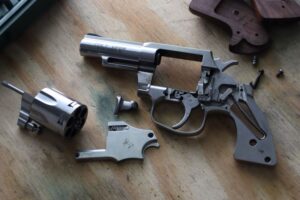
The action of the new Viper is identical to the new King Cobra and simpler than the Python. As with the rest of the revolver, the inside of the frame is forged and machined without a bur. The Python had a few cast parts and the hand that rotates the cylinder is held in pinned in place to the trigger. The new Viper’s transfer bar safety, stirrup, trigger, and hammer are all cast stainless steel. The transfer bar/hand spring rids on an outer nub on the trigger rather than internal like the Python.
Cost Comparison
These simplifications certainly brings down the cost of the Viper relative to the Python. But having shot both extensively, the Viper, has the superior action. The 2020 series Pythons have a lighter double action trigger pull compared to the old models but the change in spring geometry makes the single action pull almost as heavy as double action. The double action pull on the Viper is long and stacks heavier as the trigger moves rearward before it breaks at 5 ½ lbs. With the hammer cocked, a determined touch sets the revolver off. On my Lyman trigger scale, the single action pull breaks consistently at a noticeably lighter 4 ¼ lbs.
Colt prices the new Viper similarly to the King Cobra. The Viper also accepts the new model King Cobra grips, holsters, and speed loaders. This trim revolver is visibly smaller than the Colt Python. It’s closer to the size of a Smith & Wesson K-frame, but not so close as to take the same speed loaders, which are too tight of a fit to work in the Viper.
Viper Quick Specs
- Colt Viper Caliber: .357 Magnum/ .38 Special
- Capacity: 6
- Frame: Colt New D-Frame
- Barrel Length: 3 inches
- Overall Length: 8 1/4 inches
- Cylinder width: 1 3/8 inches
- Height: 5 inches
- Weight: 1 lb. 9 oz. loaded
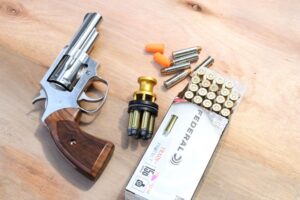
On the Range with the New Colt Viper
The .357 Magnum is a powerful round and there is no shortage of revolvers chambered for it. However, finding one that is small enough to carry but big enough to control, particularly in today’s market, can be a chore. In my own pursuit towards that end, the Colt Viper fills that niche better than scandium frame lightweights and all-steel snubbies built on a slightly smaller frame. But it is more of a handful than slightly larger S&W K-frame and Colt Python.
On the range, I put over four hundred rounds through the Viper. The diet consisted of mostly .38 Special ammunition with several boxes of .357 Magnum thrown in for good measure. I had no failures to fire of any kind, but getting around the recoil, trigger, and sights proved to be a more climactic experience.
Is the Colt Viper Accurate?
Impressions of the Trigger
I started my testing with some of my hand-loaded .38 Special 148 grain wadcutter rounds and posted a target out at ten yards. I’ve grown accustomed to Smith & Wesson triggers, it took a few cylinder’s worth of rounds to print a consistent group. Smith’s triggers in double action starts off light, then stacks heavier, before lightening and rolling to the break. The Colt gets continuously heavier until the break, which isn’t particularly heavy. Indeed, it is lighter than any other revolver I have shot in terms of trigger weight. After some dryfiring repetitions, I tried again and was able to put all six inside a 2 inch group, but about two inches high. I switched to some Remington wadcutter loads. These grouped a bit bigger and a little closer to the point of aim.
Field Testing the Revolver
Fixed sights can be very valuable for carry purposes because you generally can’t damage them or knock them out of alignment. On more than a few occasions, I have had adjustable sights break and adjust themselves. The kicker is that some ammunition will not group to the point of aim. I’d recommend you try a few loads to see what works best for you. With fixed sight revolvers like the Viper, the sights are often regulated for 158 grain bullets and lighter rounds will strike lower. The 148 grain wadcutters certainly did not. Neither did some Magtech 158 grain FMJ practice ammo. Recoil with these standard pressure loads was light and the sights were barely disturbed.
The Coke Bottle grips gave me a full firing grip and it was no more difficult to control the revolver when firing warmer .38 loads, like the Federal’s take on the famous 158 grain+P FBI load. Both 158 grain load hit an inch low from my point of aim.
Firing 357 Magnum vs 38 Special in the Viper
Ordinarily it is easier to shoot a .357 Magnum revolver with lower powered .38 Special rounds. In my case with the Viper, ease did not mean more accurately. I started off with a moderate load, Federal’s 158 grain jacketed soft point hunting round. There was more blast and the revolver jerked in my hands, but I never lost control, even as my hands got slick after a prolonged day in triple digit temperatures.
I next fired Remington 125 grain Ultimate Defense jacketed hollowpoints. This load was the gold standard among law enforcement who chose to qualify with Magnum ammunition and it is still a very potent round. The Viper certainly let me know it. My hands slipped with every shot and my support hand middle finger kept slamming into the triggerguard, given that there is space to move between the grip and the guard. Perhaps the best balance of control and power came with the Federal Hydashok 158 grain hollowpoint ammo. It was just mild enough to not break my grip, hit right on at ten yards, and consistently gave me a respectable 2.5-inch group. I also ran the ammunition across my Caldwell Chronograph to get some five-shot averages and the numbers mostly reflect the difficulty in shooting.
Velocity and Group Size Results
Ammunition Fired Average Velocity (fps) Group Size (10 Yards)
38 Special - Remington 148 Gr. WC 711 3"
38 Special - Magtech 158 Gr. FMJ 794 4"
38 Special - Federal 158 Gr. +P LHP 898 2.7"
357 Mag - Remington 125 Gr. JHP 1,441 2.9"
357 Mag - Federal 158 Gr. JSP 1,102 4"
357 Mag - Federal 157 Gr. HydraShok 1,289 2.5"
On other occasions, I took the Viper out for a workout for both some point shooting drills and on steel targets out to fifty yards. When firing any flavor of .38 Special, the Viper is deceptively fast. The full grip and balance of this three-inch model allowed me to line up the sights instinctively. The blackened out front sight is easy to find against the matte stainless surfaces that surround it. On full-size torso targets, I could reliably put all six in the 9 or 10 ring in under four seconds at ten yards and less. Going to Magnum rounds certainly slowed me down, but I was sure the targets were getting the worst end of the deal than I was. My time slowed to six rounds in six second. But with some practice, I am sure anyone can do it faster than me!
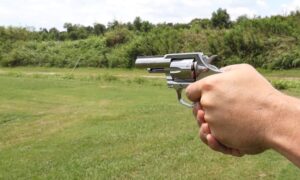
The sights started to look big on target as I stretched the distances. I had no issues connecting on steel ½ size D28 at 25 yards, but I was hit or miss on 8 inch steel plates. My hits on the bigger targets exceeded my misses at 50 yards. I think any problems came from my choking up on the trigger that my muscle memory is not quite used to.
Ejection Hassles
Although I had no failures to fire, ejecting the empty cases requires some technique or modification. With the cylinder release pulled back, letting the cylinder fall to the left side is easy. But the small and somewhat short ejector rod does not have a long enough journey to kick out Magnum cases. In fact, the rod is barely long enough to kick out the shorter Special brass. A sharp slap to the rod gets the job done, but sometimes a case will hang up on the edge of the grip and releasing the ejector rod to go home allows it to fall free. That particular grip bug did not get in the way of clearing the cases or interfering with an HKS speed loader when practicing speed reloads. A minor gripe for an otherwise solid performer.
Colt Viper .357 Magnum: Worthy Buy?
If you are like me and searching for a carry revolver that splits the difference between controllability and size, the Colt Viper is a worthwhile option. Its slightly bigger size compared to guns like the S&W Model 60 and the Ruger SP101 paid some dividends. Although some Magnum loads broke my grip, I never left the range with a swollen hand. I never got the impression that the Viper is strictly a .38 Special gun that you can use .357 if you have to. While I wouldn’t run several boxes at a time for fun, I don’t dread shooting the Viper. With the right load, it is accurate, fast, forgiving, and good looking on top of it.
